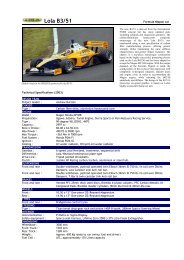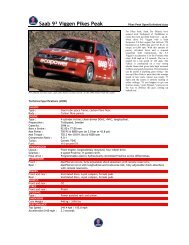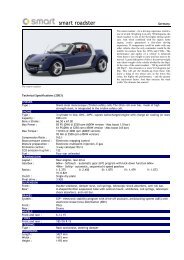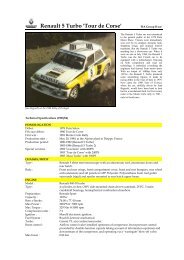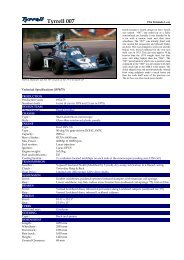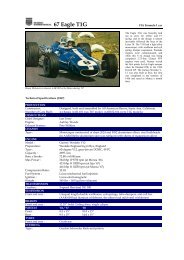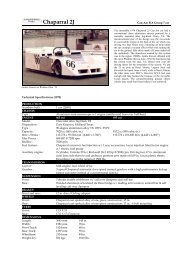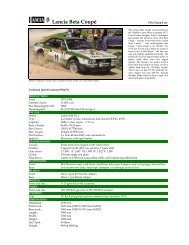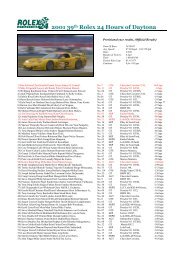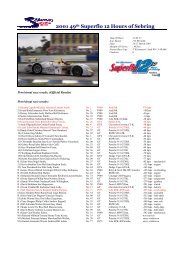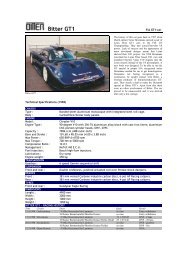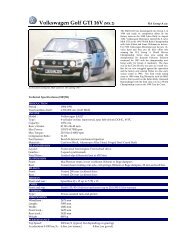83 Lancia Rally 037 - Motorsports Almanac
83 Lancia Rally 037 - Motorsports Almanac
83 Lancia Rally 037 - Motorsports Almanac
You also want an ePaper? Increase the reach of your titles
YUMPU automatically turns print PDFs into web optimized ePapers that Google loves.
Final Drive : 4.88, 5.25:1 or 5.62:1 ZF-Abarth 40% anti-slip. Two axle shafts fitted with CV- joints.<br />
SUSPENSIONS<br />
Front : Double wishbones, Bilstein dampers. Anti-roll bar.<br />
Rear : Two trailing arms. Lower side arm. Double Bilstein dampers for each wheel.<br />
BRAKES<br />
Front : Vented 300 mm Brembo-Abarth discs, 4-piston light alloy calipers.<br />
Rear : Vented 300 mm Brembo-Abarth discs, 2-piston light alloy calipers.<br />
Handbrake : Hydraulic operated on rear discs.<br />
WHEELS<br />
Front : 3-piece Speedline 8J x 16" - magnesium. (1-piece for gravel)<br />
Rear : 3-piece Speedline 10J x 18" - magnesium. (1-pierce for gravel)<br />
TYRES Evo Evo II<br />
Front : Pirelli P7 Corsa 210/595-15 Pirelli P7 Corsa SG35 230/45-16 (gravel)<br />
Pirelli P7 Corsa MS35 230/45-16 (tarmac)<br />
Hakka (snow and ice)<br />
Rear : Pirelli P7 Corsa 265/40-16 Pirelli P7 Corsa 265/40-18<br />
STEERING<br />
Type : Rack-and-pinion. 2.5 turns lock-to-lock. Two-spoke Abarth Steering wheel.<br />
ELECTRICAL SYSTEM<br />
Battery : Sieco 12V 48 Ah maintenance-free.<br />
Alternator : Marelli AA125 14V 55A 770W<br />
Head lights : 2 x H4 - 12V 60W<br />
Additional lights : 4 x H4 - 12V 150W<br />
INTERIOR<br />
Safety equipment : Two Sparco racing seats, and four point harnesses. Fire extinguisher.<br />
DIMENSIONS<br />
Lengh : 3890 mm<br />
Width : 1850 mm<br />
Height : 1240 mm<br />
Wheelbase : 2240 mm<br />
Front track : 1508 mm<br />
Rear track : 1490 mm<br />
Weight : 960 kg<br />
Fuel Cells : 2 x 35 litre<br />
PERFORMANCE<br />
Top Speed (typical) : 175 km/h (depending on gearing)<br />
Acceleration 0-100 km/h : 4.8 sec<br />
Acceleration 0-160 km/h : 10.1 sec<br />
Braking 100-0 km/h : 43.9 meters<br />
THE LANCIA RALLY <strong>037</strong> – DESCRIPTION<br />
Continuing the <strong>Lancia</strong>/Fiat rally tradition, the <strong>Lancia</strong> <strong>Rally</strong> <strong>037</strong> was launched on the 14th December 1981. The frontwheel<br />
driven Fulvia HF was the <strong>Lancia</strong> weapon of the late 1960s and early 1970s. During the 1970s the Stratos took<br />
rallying to the next level. The Fiat 131 Abarth <strong>Rally</strong> took over for the final years of the 1970s and into the 1980s. FIA<br />
announced new rules for 1982 and the next weapon was the <strong>Lancia</strong> <strong>Rally</strong> <strong>037</strong>. The <strong>037</strong> is the Abarth Project number.<br />
The first car was unveiled on 21st April 1982 at the 59th Turin International Motor Show. In 1982 two-hundred cars were<br />
built to satisfy FIA Group B homologation requirements. Twenty-one “Evolution” cars were built for competition with<br />
Bosch-Kugelfisher fuel injection, Kevlar panels and the prominent rear spoiler. They were homologated on 01.08.82 as<br />
the the model Evoluzione-1. The supercharger was replaced with a 3-port Roots type supercharger, and Bosch-<br />
Kugelfischer mechanical fuel injection was introduced from October 1982. The <strong>Rally</strong> <strong>037</strong> made the World <strong>Rally</strong><br />
Championship début at the Tour de Corse 1982. Former World Champion Walter Röhrl is signed for 19<strong>83</strong> as a team<br />
mate to incumbents Markku Alén and Attilio Bettega. The <strong>Lancia</strong> <strong>Rally</strong> <strong>037</strong> was based on the centre section of the<br />
<strong>Lancia</strong> Beta Montecarlo with tubular sub frames front and rear. The sub-frames were constructed of round cross section<br />
steel tubes connected to square cross section tubes. The centre section included the sturdy roll-bar cage made of 35 mms<br />
diameter tubes. It was powered by the Volumex R18 supercharged Fiat/<strong>Lancia</strong> 16-valve belt driven twin cam engine<br />
which sits mid ships behind the driver and is longitudinally arranged. Project Manager Sergio Limone took the decision<br />
to make use of supercharging instead of turbo charging, and he also wasn’t ready to complicate the car with a fourwheel-drive<br />
system. He wanted a conventional car with proven technology and to allow easy repairs and quick<br />
component changes during the events. The engine had its roots in previous Fiat rally cars. The block from the 124<br />
Abarth and the 16-valve head came from the 131 Abarth. Abarth engine whiz Aurelio Lampredi came up with the<br />
Volumex supercharging system which made the engine very responsive and did not suffer from any “turbo-lag”. The<br />
Kugelfischer mechanical injection system had a slide valve throttle. The 5-speed transaxle was supplied by ZF. In 19<strong>83</strong><br />
<strong>Lancia</strong> wins the Monte Carlo <strong>Rally</strong> – the first win ever for a super charged car in the World <strong>Rally</strong> Championship. The<br />
<strong>Rally</strong> <strong>037</strong> goes on to win the ’<strong>83</strong> World <strong>Rally</strong> Championship. The ever increasing competition (from mainly Audi and<br />
Peugeot) means that an “Evoluzione II” version was produced for 1984. 20 cars of these were built and homologated



